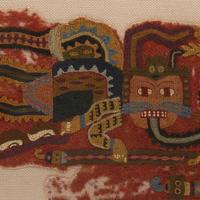Methodology
Why I choose this topic?
I chose the topic since I have always been impressed with textiles, especially Peru's ancestral textiles. I chose textiles from various Pre-Columbian cultures to show different patterns in designs, colors and uses according to the culture. Also, I selected pieces that were in good condition so that they can be better appreciated. On the other hand, the interest in these objects is because many are not cataloged nor registered. This task is a great start to do it someday. By correctly cataloging, researching, and displaying the pieces, their true value would be revealed.
Data source
The textiles' data and images are from two online museum collections in Peru and probably the only accessible textiles records. The online collections belong to the Larco Museum and The Lima Art Museum (MALI) in Lima, Peru. The information on some objects is not complete. Neither of the two museums has 100% developed their online collection.
Cataloging template
Title: The titles are the original ones from the database. Some of them were edited without changing the meaning so that the name is concise.
Description: The description of each object was obtained from the data source. I summarized the current information and put the most relevant and what most described the object. In some cases, it was difficult as they are complex pieces with much important information.
Type: For this field, LC: Subject Headings was the most accurate controlled vocabulary for these pieces. I Added "textile, ancient" because it was the most related to the object. I tried Getty: The Art & Architecture Thesaurus (AAT), LC: All, and Tesauros: Diccionario de Bienes Culturales, but I couldn't find the right word.
Creator: The creator, in this case, is unknown; the data in this field is the culture to which they belong. I couldn't use any data type.
Identifier: The identification of most of the objects was in the data source. Some objects in the MALI museum did not have that number. For those who did not have one, I created an ID by putting the museum's name's abbreviation followed by a number, e.g. (mali_01).
Date: This field is important for these textiles; the dates are also described by periods. It helps to understand the development and similarity of the cultures.
Subject: For the subject used diverse data types according to the characteristics of each piece. For some, I applied Getty: The Art & Architecture Thesaurus (AAT) and LC: Subject Headings; for others, I used only one data type. It wasn't easy to find the exact vocabulary for some pieces, as they have particular characteristics. I added between 4 and 5 words to describe the textile.
Rights: I could not use a controlled vocabulary for this field; each museum had its own right; I used text.
Format: I included the dimensions (cm) of the online collections. I added physical dimensions as an Alternate label. Some of the textiles do not have dimensions, and some of them are fragments.
Medium: For this field, I tried to add controlled vocabulary, but I could not find the specific material. The only controlled vocabulary I could find was "cotton" in LC: Subject Headings. I decided to wrote the exact material of each piece.
Coverage: For this field, I used the Geonames: The GeoNames geographical database. I included this controlled vocabulary so the map can be set automatically on the website. As there is no specific place where the object was found, the location is not exact.
Source: I included the museum's name first, and then I added the link from the online collection site.
Contributor: I included this field because some of the objects have donors. I tried with controlled vocabulary from Getty: The Union List of Artist Names (ULAN) and LC: All but neither had the names of the donors. Use text to add them.
